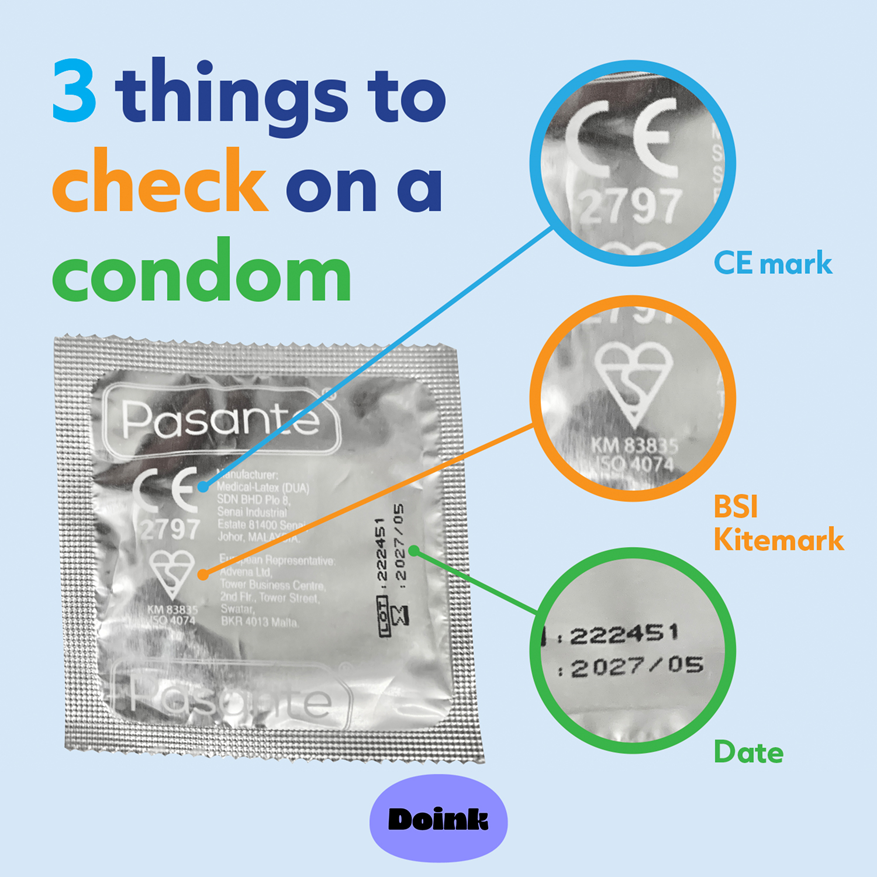Do I need to be 18 to get condoms?
No, you can get condoms even if you’re under 18.
You can get free condoms from C-Card if you’re 13 or older.
There is no age limit for buying condoms from a shop in person. No one should refuse to sell you condomsor ask to see any ID.
Online shops can be a bit different. Some online shops may have rules about how old you need to be before you can use their shop.
What are condoms for?
Condoms are to help to protect you and anyone you have sex with.
They help protect you from two things:
STIs
STIs are really common. They’re infections that are passed from person to person during sex.
You can’t tell if someone has an STI by looking at them. Someone can easily have one without knowing they have it.
Using condoms or dams means you’re much less likely to get or pass on an STI when you have sex.
External Condoms
An external condom goes over the penis. It can be used:
- To cover a penis before any contact with a vagina, anus or mouth.
- To cover a sex toy before any contact with a vagina or anus.
Internal Condoms
An internal condom can be:
- Put in a vagina or anus before contact with a penis.
- Put over a penis before any contact with an anus.
- Used to cover a sex toy before any contact with a vagina or anus.
Dams
A dam can be:
- Used to cover the vulva (area around the opening to the vagina) before any contact with a mouth.
- Used to cover the anus before any contact with a mouth.
Pregnancy
Condoms are the only type of contraception that helps protect you from pregnancy and STIs.
A pregnancy can only happen if a sperm joins together with an egg.
Sperm is found in semen (cum) from a penis. Condoms stop pregnancy by stopping sperm from getting into a vagina.
When condoms are used correctly every time you have sex, they’re very effective at preventing pregnancy.
When condoms are not used correctly every time or if something goes wrong – like the condom slipping off or breaking – then there’s a higher chance of pregnancy.
Because it can be easy to make mistakes with condoms or for something to go wrong, some people like to use condoms and another type of contraception. More about using condoms as contraception.
What are the different types of condom?
There are two main types of condom to choose from.
External Condoms
These are the most common type of condom. They’re a stretchy cover that goes over the penis. They’re sometimes called male condoms.
Use them to cover the penis during:
- Penis in vagina sex (vaginal sex)
- Penis in bum sex (anal sex)
- Sex where the penis will be in contact with the mouth or tongue (oral sex)
You can also use external condoms to cover sex toys.
There are lots of different types of external condom. They are usually made from latex but some types are made of other materials like very soft plastic. These are good if you’re allergic to latex. Non-latex condoms are often thinner than latex condoms. Some people prefer this.
You can get different types of condom from the C-Card service. Click here to view the available options.
Internal Condoms
Internal condoms are not as common as external condoms but some people prefer them. They’re worth trying to see if they suit you.
They’re a looser type of condom, a bit like a soft bag with a squashy ring at each end. They go inside the body. They’re sometimes called female condoms.
They can be put in the vagina for penis in vagina sex (vaginal sex) and some people use them inside the anus for penis in bum (anal) sex. You can also use them to cover sex toys.
Internal condoms are made of a soft material called nitrile and are latex-free.
You can order them from the C-Card service. Click here to view the available options.
How do I choose the right size condom?
This video talks you through the different condom sizes. NHS Condom Size Guide
What to check for on a condom packet
There are a few things it’s important to look for. This only takes a few seconds.
Check for at least one of these marks:
They show the condom is high quality and has been tested to high standards.
CE mark

UKCA mark

BSI kite mark

Don’t use a condom that doesn’t have one or more of these marks on the pack.
Check for any damage
Condom packets can get damaged. This can damage the condom inside. If a condom pack looks old, creased, torn or damaged in any other way, it’s best to throw the condom away and use a different one.
When you carry condoms, try not to keep them for long in places like a wallet or pocket where they could get damaged. If you keep them in your bag, you can protect them by putting them in a small tin, like a sweet tin. Try not to store them in a car or anywhere they could get very hot.
Check the expiry date.
This is a date printed on the packet.

Older condoms are more likely to be damaged or break.
As long as the packet is not damaged, the condom is safe to use until the date shown. If it’s after this date, the condom is out of date. It may not be safe to use.
If you’ve had the same condoms for a while, check them every so often. If it’s getting close to the expiry date, order some more. When your new condoms arrive, throw the old ones away.
If an out-of-date condom is the only condom available, it’s best not to have sex until you can get a new condom. If you do have sex, then an out-of-date condom may be safer than no condom at all. If the condom breaks, check what to do. What if condom breaks?
How to use an external condom
This video talks you through how to use an external condom. How to Use External Condom
How to use an internal condom
If you’ve not used an internal condom before, It’s a good idea to practice using one. This helps you get used to it before having sex.
Only use one internal condom at a time. Never use an internal condom and an external condom at the same time. The condoms rub against each other and are more likely to break.
Use a new condom every time you have sex and always check the packet.
Gently tear open the packet. Don’t use teeth or scissors to open the packet.
Be careful that jewelry or fingernails don’t damage the condom.
The condom has 2 rings – one at each end.
One end of the condom is closed. The smaller ring at the closed end is called the inner ring. This ring goes inside the vagina or anus.
The larger ring at the open end of the condom is called the outer ring. This stays outside your body.
Putting the condom into the vagina
Always put an internal condom in before the penis touches your genital area or anus.
You can put an internal condom in up to 8 hours before having sex if you want to.
Find a position that feels comfortable.
Try the same position you use to put in a tampon. It could be lying down, squatting, or putting one leg up on a chair or toilet seat.
Hold the closed end of the condom.
Squeeze the inner ring between your thumb and middle finger (the longest finger).
Slide the squeezed inner ring into the vagina. Help guide it in with your index (first) finger if you need to.
Push it up as far as you can.
Keep the outer ring outside your body. It needs to be close to the vulva (the area outside the vagina).
Putting the condom in the anus
Internal condoms have only been tested for penis in vagina sex. But some people like to use them for penis in bum (anal) sex.
If you do use an internal condom for anal sex, it’s important to know that taking out the inner ring may damage the condom and make it less effective.
Always use plenty of water-based or silicone-based lube in and around the anus.
During sex
You or a sexual partner can guide the penis into the condom. This helps make sure the penis goes into the condom.
An internal condom is designed to be loose. It will probably move around during sex. This is OK as long as the penis stays inside the condom.
It can be helpful to hold the outer ring in place to stop the condom being pushed inside you.
Taking it out
You don’t have to take the condom out straight away.
When you’re ready, twist the outer ring round a few times. This helps keep any semen (cum) in the condom.
Gently pull the condom out.
Put a used condom in the bin. You can wrap it in a tissue or toilet paper first if you want to.
Never put any type of condom down the toilet as they can block it.
If you have sex again, use a new condom.
Do I really need condoms for oral sex?
It’s possible to get and pass on STIs from oral sex
So the advice is to use condoms or dams for oral sex to help protect yourself and any partners.
Which condoms can be used for anal sex?
Regular condoms can be used for anal sex. You don’t need a special type. Some people prefer a type called “extra” or “extra safe” which are slightly thicker and have more lube than regular condoms.
It’s important to use plenty of lube for anal sex. Your bum does not produce its own natural lube and the skin inside is very thin. It’s more likely to get damaged without lube.
Either an external or an internal condom can be used – but do not use both types at the same time. The condoms rub against each other and are more likely to break.
Like any type of sex, whether to have anal sex is a personal choice. Some people enjoy it, others don’t. There is no need to try it if you don’t want to. More about anal sex.
Do I need lube?
All the condoms from the C-Card service have lube on them already.
Adding extra lube can make sex more comfortable and enjoyable. That’s why we always send you some lube with your condoms.
There are 3 main types of lube:
- Water-based lube. This is what we send you. It’s safe to be used with all types of condoms and sex toys.
- Silicone-based lube. This is safe to be used with all types of condom. Don’t use it with silicone sex toys as it can damage them.
- Oil-based lube. Never use oil-based lube, any type of oil or oil-based product with latex or polyisoprene condoms. The oil can damage the condom. Oil-based products include things like body lotion, petroleum jelly and lipstick.
You can put lube:
- In and around the vagina.
- On the penis – it can go over a condom.
- In and around the anus. It’s important to use condoms and plenty of lube if you want to have penis in bum (anal) sex.
What is a dam?
dam is a very thin, flexible square made of latex or very soft plastic.
A dam can be held over the vulva or the anus during oral sex.
It stops the mouth from directly touching the vulva or anus. This can help lower the chance of getting or passing on STIs or other germs.
It’s sometimes called a dental dam. This is because dams are sometimes used in the mouth to help protect people from infection during dental work.
You can order dams from the C-Card service. Click here
You can also make a dam by cutting up the side of a condom and opening it out. Some people like to use flavoured condoms for this. You can order flavoured condoms from the C-Card service. Click here
What if a condom breaks or comes off?
You may have a higher chance of STIs or pregnancy. It’s a good idea to do the following.
STIs
- Get a free STI test in about 2 weeks’ time. You can do this face to face or online.
- If you’re 16 or over and don’t have any symptoms, find out if you can get a free online test from SH.UK.
- If you notice any signs or symptoms that might be caused by an STI, have a face-to-face check-up as soon as you can from your local clinic.
Pregnancy
If you or a partner could get pregnant, using emergency contraception can lower the chance of pregnancy.
- Get emergency contraception as soon as possible to give it the best chance of working.
- If you can’t get it straight away, you can use it up to 5 days later.
- Where to get emergency contraception.
If a partner is living with HIV
Most people living with HIV in the UK are on effective treatment and cannot pass the virus on through sex.
A medicine called PEP may be advised to help lower your chance of getting HIV if:
- Your partner is living with HIV but not on effective treatment.
- You’re not sure of a partner’s HIV status but there’s a high chance they could have HIV.
PEP needs to be taken as soon as possible to have the best chance of working.
When and where to get PEP.
What if my partner takes off the condom during sex?
This is not OK.
Agreeing to sex with a condom is NOT the same as agreeing to sex without a condom.
If a partner takes off the condom during sex without you knowing and agreeing to it, this is sexual assault or rape. It’s sometimes called “stealthing”.
If this happens to you, it’s important to get help.
Help if you’ve been sexually assaulted.